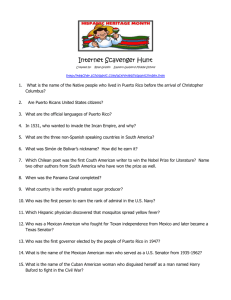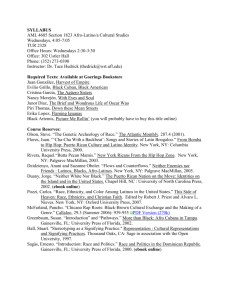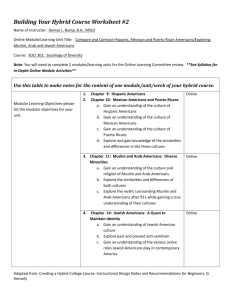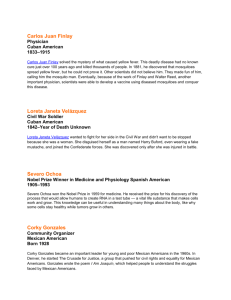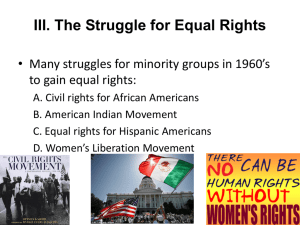CHAPTER 5
advertisement
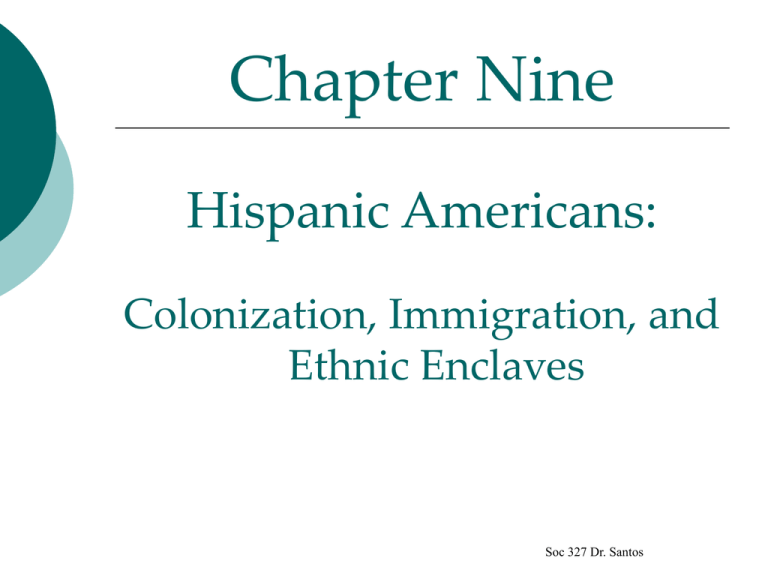
Chapter Nine Hispanic Americans: Colonization, Immigration, and Ethnic Enclaves Soc 327 Dr. Santos Colonized or Immigrant Minority Group? Before Jamestown was founded, the ancestors of some Hispanic groups were already in North America. Evolving official labels: Spanish-Speaking (50s), Hispanics (80s), Latinos/as (90s to now) Hispanics are partly an ethnic group & partly a racial minority group. Hispanic Americans as of July 2007 were 45.5 million or 15.1% of the total population; they became the largest U.S. minority group in the spring of 2001. About 60% of Latinos are native-born, 40% foreign-born. By 2050, 1 out of every 4 Americans will be Hispanic. Already majority Latinos in many counties & cities. State Latino Demographics, July 2007 California (13.2 million) had the largest Hispanic population of any state as of July 1, 2007, followed by Texas (8.6 million) and Florida (3.8 million). Texas had the largest numerical increase between 2006 and 2007 (308,000), followed by California (268,000) and Florida (131,000). In New Mexico, Hispanics comprised the highest proportion of the total population (44 percent), with California and Texas (36 percent each) next in line. In Kern County, Latinos will soon be half the population; the BCSD is > 75% Latino students. Mexican Americans Mexicans were conquered and colonized in the 19th century and used as a cheap labor in many areas of the Anglodominated economy in the Southwest. By the dawn of the 20th century, Mexican Americans resembled Native Americans in some ways, and southern African Americans in other ways. The most crucial difference was the proximity of the sovereign nation of Mexico, which facilitated constant population movement across the border continually rejuvenating Mexican culture, diplomatic support against egregious abuses, and the persistence of Spanish language as they were attacked and marginalized by Anglo society. Mexican Americans The overwhelming majority of Mexican Americans are Catholic. There is little difference between the value systems of Mexican Americans and other Americans of similar backgrounds: family values, work ethic, etc. Though Mexican Americans place more value on family relations and obligations; and machismo & patriarchy, though accentuated, is a matter of degree rather than kind These cultural differences, especially language & darker skin among some, have served as the basis for excluding or restricting Mexican Americans from the larger society; however, they also have provided a basis for group cohesion, identity and unity, that has sustained common action and protest activity. Recent Grow of the Hispanic American Population Distribution of Latinos by Regional Orgin or Ethnicity Mexican Migration Waves into U.S. Since the early 1900s (and especially since the 1960s) the Mexican American experience has been largely shaped by fluctuating immigration that can be explained by conditions in Mexico, the varying demand for labor in the low-paying, unskilled sector of the U.S. economy, and by changing federal immigration policy as US hegemony rose and declined in the 20th Century . Uneven foreign economic development and the 1910 Mexican Revolution WWI and European and Asian immigration restrictions Depression and repatriation campaigns (early 30s) WWII, the Bracero Program, and “Operation Wetback” (mid50s) 1965 Immigration Act and family preferences Immigration Reform and Control Act of 1986 Immigration Reform of 1996 with renewed restrictions Mexican Americans The flow of population from Mexico was and is stimulated and sustained by powerful political and economic interests in the United States. XX Century Mexican immigrants entered a social system in which a colonized status for the group had already been established. The twisting history of U.S. policy on Mexican immigration should serve as a reminder that levels of prejudice, racism, xenophobia and discrimination increase as competition and the sense of threat between nativeforeign groups increases and as foreigners are scapegoated: Anti-Mexican sentiment has dramatically risen since the 1990s. Mexican Americans in the XX Century Throughout much of the 20th century, Mexican Americans were limited to the less desirable, low-wage jobs; split labor markets have been common. The workforce has often been further split by gender, with Mexican American women assigned to the worst jobs and receiving the lowest wages in both urban and rural areas. Until the Chicano Movement of the late 1960s, Mexican Americans were excluded from political, educational, and legal institutions of the larger society by law and by custom. Discrimination in the criminal justice system, labor exploitation, and civil rights violations were continual grievances of Mexican Americans throughout the century, usually deemed “foreigners” despite changing ratios of f-born to n-born. Mexican Americans in the XX Century Unlike immigrants from Europe, Mexican Americans tended to work and live in rural areas distant from and marginal to the urban centers of industrialization and opportunities for education, skill development, and upward mobility. As Chicanos urbanized, they continued to serve as a colonized, exploited labor force concentrated at the lower end of the stratification system. The flow of immigration kept Mexican culture and the Spanish language alive. Although some Mexican Americans have acculturated and integrated, a large segment of the group continues to fill the same economic role as their ancestors. Mexican Americans Organized local resistance and protest stretch back to the original conquest period in the mid-19th century: Gorras Blancas in N.M., social banditry, mutualista associations. Regional and national organizations made their appearance early in the 20th century and were integrationist and assimilationist in nature—LULAC. Mid-20th century labor organizing and WWII brought about new organizations that changed the focus from assimilation per se, and worked to address a broad array of community, labor, problems and to increase political power—Community Service Organization and the American GI Forum. Chicano Movement The 1960s/70s Chicano movement was guided by a renewed ethnic identity & militant assertion of Chicanismo, captured byt the slogan “Chicano Power”. The movement questioned the value of assimilation, instilled ethnic pride, and exposed the continuing exploitation & exclusion of Mexican Americans from the mainstream of US life. The movement produced important organizations and leaders: Reies Lopez Tijerina and Alianza de Pueblos (1963) in NM Rodolfo Gonzalez and Crusade for Justice (1965) in CO Jose Angel Gutierrez and La Raza Unida Party (1973) in TX Cesar Chavez & Dolores Huerta and United Farm Workers (1965) in CA Chicanas in the Movement Dolores Huerta was a central figure in the movement to organize farm workers and worked closely with Cesar Chávez. She’s still active in local, national, and international social justice issues. However, Chicanas as such encountered much sexism and gender discrimination within the movement, => fought back! Chicanas helped to organize poor communities and worked for educational opportunity, welfare reform, against the Vietnam War, etc.. Continuing issues include domestic violence, child care, and the racial and gender oppression that limits all women of color. New Salience of Immigration Issue The immigration-related issues have become much more salient since the 1970s: Enormous demographic growth fed by immigration Issue of (mostly Mexican, Central American & Caribbean) unauthorized (illegal) immigration: Family unification issues: most households are mix-status Human trafficking & deaths: over 4000 since 1996 Operation Guardian Labor exploitation: still farmworkers (> 70%) but mostly urban-bound to certain occupations (construction, hotels, etc.) Labor & social organizing: Federaciones, Remittances, and the New Immigrant Rights Movement! Renewal of xenophobia in the U.S. affecting Latino-non-Latino relations: prop’s 187, 209, 227 Affecting U.S.-Mexico relations: the border wall. Affecting U.S. politics, state-federal relations, electoral trends, etc. Half of all Mexican-born in the US are undocumented Mexican Legal Migration to U.S. Foreign Born: Totals & Percentages, 1850-2006 The US experienced two waves of inmigration 1820-2004 LegalU.S. US Immigration immigration, 1820-2004 10,000,000 European 9,000,000 Latin/Asian (no prior visa required) (prior visa required) 8,000,000 7,000,000 6,000,000 Africa Asia 5,000,000 America Europe 4,000,000 3,000,000 2,000,000 1,000,000 0 4 -2 0 2 0 01 -2 91 9 1 0 0 0 0 -9 0 1 9 81 -8 0 1 9 71 -7 0 1 9 61 -6 0 1 9 51 -5 0 1 9 41 -4 0 1 9 31 -3 0 1 9 21 -2 0 1 9 11 -1 0 0 9 1 9 -1 91 8 1 01 0 -9 0 1 8 81 -8 0 1 8 71 -7 0 1 8 61 -6 0 1 8 51 -5 0 1 8 41 -4 0 31 -3 1 8 1 21 1 8 8 20 - Immigration to, Deportation from U.S., 1820-2004 Immigrated 1820-2004 = 69.9 million Deported 1825-2004 = 45.1 million 16,000,000 14.5 14,000,000 12,000,000 10,000,000 10.2 8,000,000 8.0 7.5 Europe 6,000,000 America 4,000,000 Asia 4.7 4.0 Africa 2,000,000 Deported 1.6 Deported Asia Europe 1991-2000 1951-60 1931-40 1911-20 1891-1900 1871-80 1851-60 1820 1831-40 1971-80 1.4 - European Union Free Transit Area Puerto Ricans Puerto Rico became a territory of the United States after the defeat of Spain in the Spanish-American War of 1898. As the century wore on, U.S. firms began to invest in and develop the sugarcane industry that decreased opportunities for economic survival in the rural areas and forcing many peasants to move into the cities (Portes, 1990, p. 163). Movement to the mainland began gradually and increased slowly until the 1940s, when the number of Puerto Ricans on the mainland increased more than fourfold, to 300,000, and during the 1950s, it nearly tripled, to 887,000 (U.S. Commission on Civil Rights, 1976, p. 19). Puerto Ricans Puerto Ricans became citizens of the United States in 1917, which facilitated their movement. Unemployment was a major problem on the island. Puerto Ricans were “pulled” to the mainland by the same labor shortages that attracted Mexican immigrants during and after World War II. Puerto Ricans moved to the Northeast Took jobs in the low-wage, unskilled sector of the job market Concentrated in urban labor markets (Portes, 1990, p. 164) Puerto Ricans Movement was facilitated by affordable air travel between San Juan and New York City, the major center of settlement for Puerto Ricans even before annexation. Puerto Ricans on the mainland remain centered in New York City, and more than two thirds currently reside in the cities of the Northeast (U.S. Bureau of the Census, 2000m). The rate of Puerto Rican migration has followed the cycle of boom and bust, just as it has for Mexican immigrants. Although economically diversified, the bulk of the group remains concentrated in lower-status jobs as unskilled factory and service sector laborers (males), or employed as domestics or seamstresses for the garment industry (females) in New York City (Portes, 1990, p. 164). Puerto Ricans Puerto Ricans are overwhelmingly Catholic, but the religious practices and rituals on the mainland are quite different from those on the island. Even though skin color prejudice still exists in Puerto Rico, it was never as categorical as on the mainland. In the racially dichotomized U.S. culture, many Puerto Ricans feel they have no clear place. Puerto Ricans Puerto Ricans arrived in the cities of the Northeast long after the great wave of European immigrants and several decades after African Americans began migrating from the South. Puerto Ricans share many problems with other urban minority groups of color: poverty, failing educational systems, and crime. Puerto Ricans on the mainland combine elements of both an immigrant and a colonized minority experience. Puerto Rican culture retains a strong vitality and is continually reinvigorated by the considerable movement back and forth between the island and the mainland. Cuban Americans The contact period for Cuban Americans dates back to the Spanish-American War. Despite its nominal independence, the United States remained heavily involved in Cuban politics and economics for decades, and U.S. troops actually occupied the island on two different occasions. The development of a Cuban American minority group bears little resemblance to the experience of either Chicanos or Puerto Ricans. Cuban Americans The conditions for a mass immigration were created in the late 1950s when a Marxist revolution brought Fidel Castro to power in Cuba. The first Cuban immigrants to the United States tended to come from the more elite classes and included affluent and powerful people. The U.S. government welcomed the new arrivals as political refugees fleeing from communist tyranny. Many profoundly Americanized Cuban exiles viewed southern Florida as an ideal spot from which to launch a counterrevolution to oust Castro. (Portes, 1990, p. 165). Cuban Americans Immigration was considerable for several years. In 1980, a wave of immigrants generated a great deal of controversy in the United States because the Cuban government used the opportunity to rid itself of a variety of convicted criminals and outcasts. However, the Marielitos also included people from every segment of Cuban society, a fact that was lost in the clamor of concern about the “undesirables” (Portes & Manning, 1986, p. 58). Cuban Americans Today, Cuban Americans remain one of the most spatially concentrated minority groups in the United States (67% in Florida; 52% in Miami; U.S. Bureau of the Census, 2000s), which has created a great deal of civil disorder over the years. Cuban Americans rank higher than other Latino groups on a number of dimensions, a reflection of the educational and economic resources they brought with them from Cuba and the favorable reception they enjoyed from the United States (Portes, 1990, p. 169). The differences run deeper and are more complex than a simple accounting of initial resources would suggest as Cubans adapted to U.S. society in a fundamentally different way than the other two Latino groups. Cuban Americans Cuban Americans are an enclave minority. An ethnic enclave is a social, economic, and cultural subsociety controlled by the group itself, located in a specific geographical area or neighborhood inhabited solely or largely by members of the group. The enclave encompasses sufficient economic enterprises and social institutions to permit the group to function as a self-contained entity, largely independent of the surrounding community. Cuban Americans The fact that the enclave economy is controlled by the group itself is crucial. The ethnic enclave provides a platform from which Cuban Americans can pursue economic success independent of their degree of acculturation or English language ability. The fact that success came faster to Cubans that were less acculturated reverses the prediction of many theories of assimilation. Cuban Americans Cuban Americans are neither the first nor the only group to develop an ethnic enclave, and their success has generated prejudice and resentment from the dominant group and from other minority groups. Higher-status Cuban Americans have been stereotyped as “too successful,” “too clannish,” and “too ambitious.” This stereotype of Cubans is an exaggeration and a misperception that obscures the fact that poverty and unemployment are major problems for many members of this group. Contemporary Hispanic-White Relations The level of Latino prejudice has declined, but prejudice and racism against Latinos tend to increase during times of high immigration. Research shows that Hispanic groups’ rates of acculturation increase with length of residence and are higher for the native born Racial factors have complicated and slowed the process of assimilation for many Latinos. Cultural differences reflect the recency of immigration. Contemporary Hispanic-White Relations Regional concentrations of Latinos in 2000 reflect the legacies of their varied patterns of entry and settlement. Within each of these regions, Latino groups are highly urbanized. Hispanics are generally less residentially segregated than African Americans but more segregated than Asian Americans, with the highest levels of segregation in the cities of the Northeast Contemporary Hispanic-White Relations Contemporary Hispanic-White Relations Contemporary Hispanic-White Relations Levels of education for Hispanic Americans have risen in recent years but still lag behind national standards. Lower levels of education are the cumulative results of decades of systematic discrimination and exclusion further reduced, in the case of Mexican Americans, by the high percentage of recent immigrants who bring very modest educational backgrounds. Given the role that educational credentials have come to play in the job market, these figures support the idea that assimilation will be segmented and suggest that opportunities for upward mobility will continue to be limited. Contemporary Hispanic-White Relations Contemporary Hispanic-White Relations The political resources available to Hispanic Americans have increased over the years, but the group is still proportionally underrepresented. The number of Hispanics of voting age has more than doubled in recent decades, yet the Hispanic community has not had an impact on the political structure proportionate to its size. With their rapid growth rate, it is clear that the Hispanic voters will have a much greater impact on politics in the future, especially as second- and thirdgeneration children reach voting age (Del Pinal & Singer, 1997, p. 42). Contemporary Hispanic-White Relations The economic situation of Hispanic Americans is mixed. The unemployment rates for Hispanic Americans run about twice the rate for non-Hispanic whites, and the poverty rates for the group as a whole are comparable to those of African Americans (Camarillo & Bonilla, 2001, pp. 110-111). As was the case with African Americans and Native Americans, these economic differences are even wider when we consider wealth (savings, property, stocks and bonds, etc.) as opposed to income. Contemporary Hispanic-White Relations Contemporary Hispanic-White Relations Contemporary Hispanic-White Relations Contemporary Hispanic-White Relations Contemporary Hispanic-White Relations The socioeconomic profiles of Mexican Americans and Puerto Ricans reflect their concentration in the low-wage sector of the economy, the long tradition of discrimination and exclusion, and the lower amounts of human capital (education, job training) controlled by these groups. Cuban Americans, buoyed by a more privileged social class background and their enclave economy, rank higher on virtually all measures of wealth and prosperity. These figures point to a split labor market differentiated by gender, within the dual market differentiated by race and ethnicity. Female-headed Latino families are affected by a triple economic handicap: They have only one wage earner, whose potential income is limited by discrimination against both women and Latinos. Contemporary Hispanic-White Relations The extent of intimate contact between Hispanic Americans and the dominant group is probably higher than for either African Americans or Native Americans. Some studies report that contact is greater for the more affluent social classes, in the cities, and for the younger generations (who are presumably more Americanized) Rates of intermarriage are higher for Latinos (3.5%) than for African Americans (< 1%) Assimilation and Hispanic Americans As test cases for what we have called the traditional view of American assimilation, Latinos fare poorly as there is no single experience or pattern of adjustment to the larger society. Their experiences also illustrate some of the fundamental forces that shape the experiences of minority groups: the split labor market and the U.S. appetite for cheap labor, the impact of industrialization, the dangers of a permanent urban underclass, the relationships between competition and levels of prejudice and rejection, and the persistence of race as a primary dividing line between people and groups.
